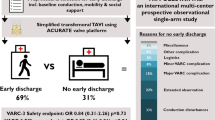Abstract
While percutaneous catheter closure proves an effective treatment for secundum atrial septal defect (ASD2), some child patients require surgical closure. We assessed the risks associated with isolated surgical ASD2 closure by reviewing the outcomes of 120 children operated on between 1999 and 2011 (mean age 4.6 ± 3.9 years, mean weight 17 ± 12 kg). Direct sutures were performed in 4% and patch closures in 96%. The mean cardiopulmonary bypass duration was 38 ± 14 min, aortic cross-clamp time 19 ± 9 min, intensive care unit length of stay 1.6 ± 1.1 days, hospital stay 11.2 ± 5.1 days. There were no complications in 60 patients (50%) and major complications in 8 (6.7%), with 1 patient (0.8%) dying of pneumonia-induced sepsis, 2 (1.7%) requiring revision surgery, 3 (2.5%) requiring invasive treatment (2 pericardial drainage, 1 successful resuscitation), and 2 (1.7%) presenting thromboembolisms (1 cerebral stroke, 1 cardiac thrombus). In hospital minor complications occurred in 22 patients: 17 pericardial effusions (15%), 15 infections requiring treatment (12.5%), 1 sternal instability (0.8%), 4 anemias requiring transfusion (3.3%), 7 pulmonary atelectasis (6%), and 2 post-extubation glottis edema (1.7%). At early outpatient follow-up, complications occurred in 21 patients: 16 (13.3%) pericardial effusions, 4 (3.3%) infections requiring treatment, and 3 (2.5%) keloid scarring. No complications occurred during long-term follow-up. In line with published data, mortality was low (0.8%), yet major complications (6.7%) were more common in these cases than those following percutaneous ASD2 closure. Minor complications were frequent (43%) with no long-term sequelae.

Similar content being viewed by others
References
Batisse A, Fermont L, Lévy M (2013) Cardiologie pédiatrique pratique, 4th edn. Doin, Paris, p 57–61
Crawford MH (2009) Current diagnosis and treatment: cardiology, 3 edn. Lange McGraw Hill, San Francisco, p 379–384
Carbonez K, Oztürk N, Moniotte S, Ovaert C, Shango P, Barrea C, Rubay J, Sluysmans T (2013) Long-term follow-up 10 years after transcatheter closure of atrial septal defect in 241 children. Cardiol Young 23(Supplement 1):S124–P172
Galal MO, Wobst A, Halees Z, Hatle L, Schmaltz AA, Khougeer F, De Vol E, Fawzy ME, Abbag F, Fadley F et al (1994) Peri-operative complications following surgical closure of atrial septal defect type II in 232 patients—a baseline study. Eur Heart J 15:1381–1384
Hughes ML, Maskell G, Goh TH, Wilkinson JL (2002) Prospective comparison of costs and short term health outcomes of surgical versus device closure of atrial septal defect in children. Heart 88:67–70
Butera G, Carminati M, Chessa M, Youssef R, Drago M, Giamberti A, Pomè G, Bossone E, Frigiola A (2006) Percutaneous versus surgical closure of secundum atrial septal defect: comparison of early results and complications. Am Heart J 151:228–234
Bialkowski J, Karwot B, Szkutnik M, Banaszak P, Kusa J, Skalski J (2004) Closure of atrial septal defects in children: surgery versus Amplatzer device implantation. Tex Heart Inst J 31:220–223
Durongpisitkul K, Soongswang J, Laohaprasitiporn D, Nana A, Sriyoschati S, Ponvilawan S, Subtaweesin T, Kangkagate C (2002) Comparison of atrial septal defect closure using Amplatzer septal occluder with surgery. Pediatr Cardiol 23:36–40
Gil-Jaurena JM, Zabala JI, Conejo L, Cuenca V, Picazo B, Jiménez C, Castillo R, Ferreiros M, de Mora M, Gutiérrez de Loma J (2011) Minimally invasive pediatric cardiac surgery. Atrial septal defect closure through axillary and submammary approaches. Rev Esp Cardiol 64:208–212
Costa RN, Ribeiro MS, Pereira FL, Pedra SR, Jatene MB, Jatene IB, Ferreiro CR, Santana MV, Fontes VF, Pedra CA (2013) Percutaneous versus surgical closure of atrial septal defects in children and adolescents. Arq Bras Cardiol 100:347–354
Mishra S, Tomar M, Malhotra R, Radhakrishnan S, Mishra Y, Iyer KS, Shrivastava S, Trehan N (2008) Comparison between transcatheter closure and minimally invasive surgery for fossa ovalis atrial septal defect: a single institutional experience. Indian Heart J 60:125–132
Kim JJ, Hijazi ZM (2002) Clinical outcomes and costs of Amplatzer transcatheter closure as compared with surgical closure of ostium secundum atrial septal defects. Med Sci Monit 8:CR787–CR791
Butera G, Biondi-Zoccai G, Sangiorgi G, Abella R, Giamberti A, Bussadori C, Sheiban I, Saliba Z, Santoro T, Pelissero G, Carminati M, Frigiola A (2011) Percutaneous versus surgical closure of secundum atrial septal defects: a systematic review and meta-analysis of currently available clinical evidence. EuroIntervention 7:377–385
Jones TK, Latson LA, Zahn E, Fleishman CE, Jacobson J, Vincent R, Kanter K (2007) Results of the U.S. multicenter pivotal study of the HELEX septal occluder for percutaneous closure of secundum atrial septal defects. J Am Coll Cardiol 49:2215–2221
Jones DA, Radford DJ, Pohlner PG (2001) Outcome following surgical closure of secundum atrial septal defect. J Paediatr Child Health 37:274–275
Bové T, François K, De Groote K, Suys B, DeWolf D, Van Nooten G (2005) Closure of atrial septal defects: is there still a place for surgery? Acta Chir Belg 105:497–503
Author information
Authors and Affiliations
Corresponding author
Ethics declarations
Conflict of interest
The authors declare that they have no conflicts of interest.
Rights and permissions
About this article
Cite this article
de Beco, G., Mambour, N., Vô, C. et al. Recent Experience and Follow-Up After Surgical Closure of Secundum Atrial Septal Defect in 120 Children. Pediatr Cardiol 39, 1440–1444 (2018). https://doi.org/10.1007/s00246-018-1914-8
Received:
Accepted:
Published:
Issue Date:
DOI: https://doi.org/10.1007/s00246-018-1914-8




